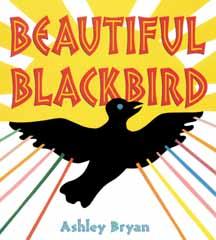| Beautiful blackbird Author: Bryan, Ashley | ||
| Price: $24.48 | ||
Summary:
In a story of the Ila people, the colorful birds of Africa ask Blackbird, whom they think is the most beautiful of birds, to decorate them with some of his "blackening brew."
| Accelerated Reader Information: Interest Level: LG Reading Level: 3.70 Points: .5 Quiz: 66794 | Reading Counts Information: Interest Level: K-2 Reading Level: 2.80 Points: 1.0 Quiz: 34593 | |
Awards:
Coretta Scott King Illustrator Award, 2004
Common Core Standards
Grade K → Reading → RL Literature → K.RL Key Ideas & Details
Grade K → Reading → RL Literature → K.RL Craft & Structure
Grade K → Reading → RL Literature → K.RL Integration of Knowledge & Ideas
Grade K → Reading → RL Literature → Texts Illustrating Complexity, Quality, & Range
Grade 1 → Reading → RL Reading Literature → Texts Illustrating the Complexity, Quality, & Rang
Grade K → Reading → RL Literature → K.RL Range of Reading & Level of Text Complexity
Grade 1 → Reading → RL Reading Literature → 1.RL Key Ideas & Details
Grade 1 → Reading → RL Reading Literature → 1.RL Integration of Knowledge & Ideas
Grade 1 → Reading → RL Reading Literature → 1.RL Range of Reading & Level of Text Complexity
Grade 2 → Reading → RL Reading Literature → 2.RL Key Ideas & Details
Grade 2 → Reading → RL Reading Literature → 2.RL Integration & Knowledge of Ideas
Grade 2 → Reading → RL Reading Literature → Texts Illustrating the Complexity, Quality, & Rang
Reviews:
Kirkus Reviews (12/01/02)
School Library Journal (01/03)
Booklist (01/15/03)
The Bulletin of the Center for Children's Books (A) (02/03)
Full Text Reviews:
Bulletin for the Center... - 02/01/2003 Bryan tells the story of Blackbird, who, “a long, long time ago,” was voted the most beautiful of all the birds in Africa. The pallid Ringdove takes Blackbird aside and asks, “Oh, Blackbird, Blackbird, coo-coo-roo, coo-ca-roo, would you color me black so that I’ll be black like you?” Blackbird explains that “color on the outside is not what’s on the inside,” but he promises to brew some blackening in his medicine gourd to “swing a ring” around Ringdove’s neck to go along with his name. Not surprisingly, when Ringdove is thus decorated the other birds want decorations, too, and Blackbird uses his blackening potion to make them all happy. The plot is somewhat slight and the momentum sometimes falters, but Bryan’s adaptation of this African tale (from the Ila people of Zambia, according to a source note) makes good use of syncopated language that suffuses the proceedings with joie de vivre. Cut-paper collage birds of many colors flutter through the pages against white and colored backgrounds; on some pages the hues seem washed out, and even when the defining black is added the compositions are scattered, lacking the driving rhythm of the text. The contrast between the black decorations and the colored paper lends emphasis to the visuals and to the message, however, and the new-construction-paper freshness of the medium will invite appreciation from skillful young scissors-wielders. A clear message, replicable art techniques, and storytelling possibilities make this a title rife with potential curricular connections. - Copyright 2003 The Board of Trustees of the University of Illinois.
School Library Journal - 01/01/2003 K-Gr 2-Because they haven't got a spot of black on their bodies, the colorful birds of Africa envy Blackbird. They extol his feathers that "gleam all colors in the sun" in their songs and dances. And although he assures them that "Color on the outside is not what's on the inside," he generously shares the blackening brew in his gourd. First he adds a necklace of midnight to Ringdove, then markings of black to every feathered creature large and small, causing them to finally sing, "Oh beautiful black, uh-huh, uh-huh/Black is beautiful, UH-HUH!" Adapted from an Ila tale from Zambia, this story delivers a somewhat contradictory message. Blackbird frequently affirms that it's what's inside that counts but his avian friends are certainly fixated on adding some black to their feathered finery. The story line is simple and the rhythmic chants of the flock frequently interspersed throughout the text add drama and a rapper's cadence. The cut-paper silhouettes are colorful but static, effectuating a stylized formality. The endpapers include an image of the scissors used to create the collages and reinforce the physical process behind the art. This unusual and little-known pourquoi tale may supplement larger collections and serves as a thoughtful and entertaining addition to units on self-esteem.-Carol Ann Wilson, Westfield Memorial Library, NJ Copyright 2003 Cahners Business Information. - Copyright 2003 Publishers Weekly, Library Journal and/or School Library Journal used with permission.
Booklist - 01/01/2003 In this simple adaptation of a tale from the Ila-speaking people of Zambia, the message is clear: Black is beautiful. Once upon a time, Blackbird was the only bird of Africa who wasn't brightly colored. When Ringdove asks who is the most beautiful bird, the other birds name Blackbird. At Ringdove's request, Blackbird brings blackening from his medicine gourd to decorate Ringdove's colored neck; the other birds also want trimming, so Blackbird paints dots and brushes lines and arcs until his gourd is empty. Using a more vivid palette than usual, Bryan employs boldly colored, cut-paper artwork to dramatize the action. The overlapping collage images fill the pages with energy as the songlike responses of the birds tap out a rhythm punctuated with uh-huhs. In an author's note, Bryan explains that the scissors pictured on the endpapers, which Bryan used to create the collages, were once also used by his mother. Ready-made for participative storytelling. - Copyright 2003 Booklist.



